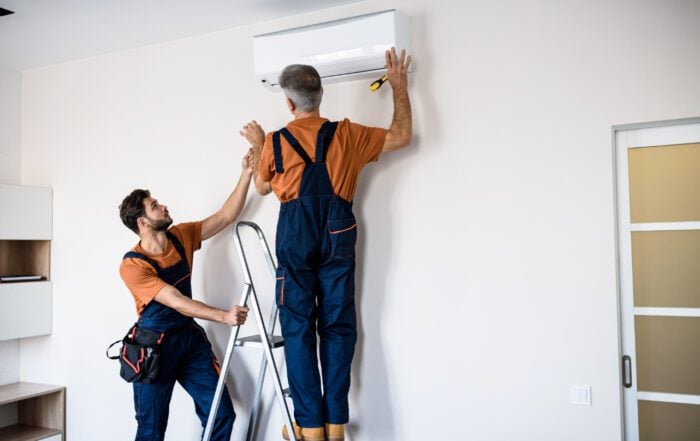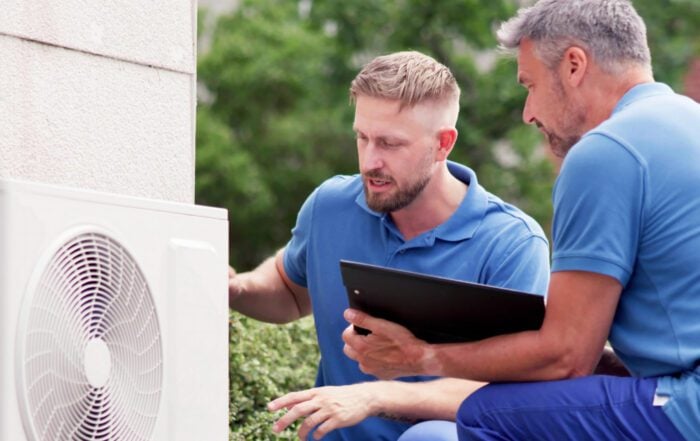Energy savings should be a year-round goal, but with winter here, certain areas of your home should receive greater attention. Heat loss and low-efficiency equipment can cost you a great deal over the course of a typical northeast Ohio frigid season. Here are a few suggestions, affordable tips, and tricks to maximize household winter energy efficiency and reduce your energy costs. Several of these steps cost nothing at all, so what have you got to lose?
Winter Energy Efficiency Tips
Air Leaks
To strategize whole-house winter energy efficiency, you should consider things like heat pump efficiency and scheduled maintenance. However, one of the most vital considerations is ensuring that your home is as airtight and well insulated as possible. If you feel drafts from the windows or doors, it means you are losing heated air. These leaks are found throughout your home, from your attic to your basement. Drafty windows and doors, as well as leaks around pipes, electrical cables, exhaust vents, appliance flues, and other penetrations in your exterior walls or attic floor can significantly increase your heating and cooling bills.
Luckily, you can address most of these issues through simple weatherstripping methods. Sealing these leaks or adding weatherstripping can save you significantly. Common areas of interest include gaps around:
- Doors
- Ducts
- Pipes
- Vents
- Windows
- Wires
Don’t forget to add door sweeps to the bottom of exterior doors and seal all other penetrations with caulk or expanding foam insulation. You should also check ductwork for air leaks; these can be sealed easily and affordably. (Continue reading below for tips on sealing these types of leaks.)
Duct leaks
If your ducts are leaking, you could be wasting as much as 30 percent of the air you’re paying to condition your home. That’s a huge loss in savings. If possible, hunt down leaks in accessible ductwork. Then patch them up with duct mastic or metal-backed tape. For a more thorough duct sealing, acquire the services of a professional. A trained technician can find, reach, and seal duct leaks which the typical homeowner cannot.
Insulation
When you diagram whole-house winter energy efficiency, one of the keys to getting the efficiency you want is to make sure that your home is properly insulated. Adequate insulation is a key factor in maximizing household energy savings. If your insulation is lacking or has become damaged over the years, you should consider upgrading it. Older homes often have inadequate insulation which is not properly installed.
To get the most bang for your buck, start with the attic. When you ensure that the top space of your home is properly sealed and insulated, it can significantly reduce energy loss. A comprehensive insulation plan also includes walls, ceiling, floors, and the basement or crawl space. You can even gain energy savings by insulating ductwork and plumbing, especially in unconditioned areas of the home.
It’s not always easy to check wall insulation, but you can get access through wall outlets. Just make sure the power is off first. If there is inadequate insulation, hire a professional to add expanding foam or loose fill insulation. Also, check the depth and positioning of your attic insulation. It should be placed between the joists and rise just above them.
In the Cleveland area, your attic insulation should be between R-38 and R-60. Walls should feature insulation between R-13 to R-21, and floors should have insulation between R-25 to R-30. In your attic, you can easily add fiberglass batts. Loose-fill insulation can be added over existing insulation and in your floor and walls. Blown-in or injected foam can also be added to existing construction with minimal work. Have a contractor inspect your current insulation and add more if necessary.
HVAC components
Once you address your household winter energy efficiency, take a look at your heating and cooling equipment. Routine system maintenance is necessary when it comes to optimizing comfort and efficiency. However, if your systems are getting older, it may be time to consider high-efficiency replacements. Condensing gas furnaces, for example, offer an energy efficiency rating of over 98 percent. That means almost all the furnace-used energy is converted directly into heat.
If your system isn’t at an age where it should be replaced, look into a maintenance program. Have your system serviced at least once a year to keep it running as efficiently as possible. Although there is some expense associated with preventive maintenance, it will cost you less in the long run. Well-maintained equipment will operate more efficiently, requires fewer repairs, and will keep your home more comfortable. As an added note, make sure to check your air filter regularly.
Replace Appliances
When you need a new appliance such as a refrigerator or water heater, choose Energy Star-rated models. These will bring you the most savings. You can also keep your water heater at 120 degrees to save even more energy. For even more information on how to improve your home efficiency, talk to our experts.
A systematic appraisal of your home is necessary to strategize whole-house winter energy efficiency. Repairing problems with leaks or insulation is an important part of this – but so are everyday actions. There are things you can do in your home to keep costs down and winter energy efficiency up.
Everyday Savings Tips
Use your programmable thermostat
If you haven’t reviewed your thermostat settings in awhile, do it now. For every degree you turn it down, you can save up to 3 percent on your heating bill. That may not seem like much, but those savings can really add up. Try dropping the thermostat 10 degrees when you’re at work or away for the weekend.
Turn off exhaust fans
While you should use the fans in your kitchen and bathroom to vent warm, humid air, you should also turn them off after they’ve done their job. Allowing them to continually run eats away at energy costs.
Pay attention to your curtains
It’s a small step that takes almost no time at all. Opening south-facing curtains during the day and closing all your curtains at night. This allows sunlight to help heat your home during the day and keeps heat in at night. It also gives your furnace (and your wallet) a bit of a break.
Tips for Weatherization Applications for Winter Energy Efficiency
This season, increase energy efficiency by weatherizing your home. Here are several tips to make sure that you complete your weatherization project the right way.
Properly diagnose the issues
Use a blower door test. It forces air throughout the home and measures how much of the air is escaping. In addition, you might consider using an infrared camera to detect major areas of conditioned air loss in the home. Once this diagnostic phase is complete, it’s time to start applying some weatherization techniques in the identified problem areas.
Use caulking glue to weatherize windows
Windows are often one of the greatest sources of leaks. Before using caulk to seal the cracks around the windows, be sure the area is totally clean. Once you’re ready to apply the caulk, move steadily along the outer edge of the window positioning the tube at a 45-degree angle. After you have finished applying the glue, use a gloved finger to run back over the glue to make it smooth and uniform.
Secure areas around exterior doors
Use high-quality weatherstripping and apply it properly. Be sure to purchase the weatherstripping that fits your door, and measure each piece against each side of the door jamb before applying it.
Tips for Sealing Air Leaks for Winter Energy Efficiency
For leaks in windows
As we mentioned above, a closed window may seem like it is containing air flow, but this is the most common area where air leaks occur. Caulking around the windows or adding new weather stripping is a cheap and easy way to seal air leaks.
For leaks near recessed lights
Recessed lights have grown in popularity with homeowners but are a prime cause of air leaks. Since their electrical components are located in the attic, air can leak down into your house. The light fixture itself or the packaging should say if your light is I.C. (insulation contact) rated. If so, then insulating every unit is easy. However, a light which is not I.C. rated cannot be in contact with insulation as it is a fire hazard. You can still seal air leaks around your recessed lights, but proceed with caution.
For leaks around doorways
Like windows, air leaks often occur under or around the door, leading to higher energy bills. The best way to detect air leaks is to search around your doorway for spots where you can see outside. Some weather stripping will take care of the problem.
If you have questions regarding the efficiency of your HVAC system or need help addressing household energy loss, speak to one of our trained technicians. For more energy saving ideas, contact the experts at Stack Heating, Cooling, Plumbing and Electric. We can help you identify the sources of energy loss in your home, so you can make the necessary changes to bring your energy costs down. Joining our Comfort Club Maintenance Program is a good first step toward saving on heating costs this win
Have Any Questions?
If this is an emergency please call 440-937-9134.
Otherwise, please feel free to call us or submit this form to schedule an appointment for service or request an estimate. We will contact you shortly!



